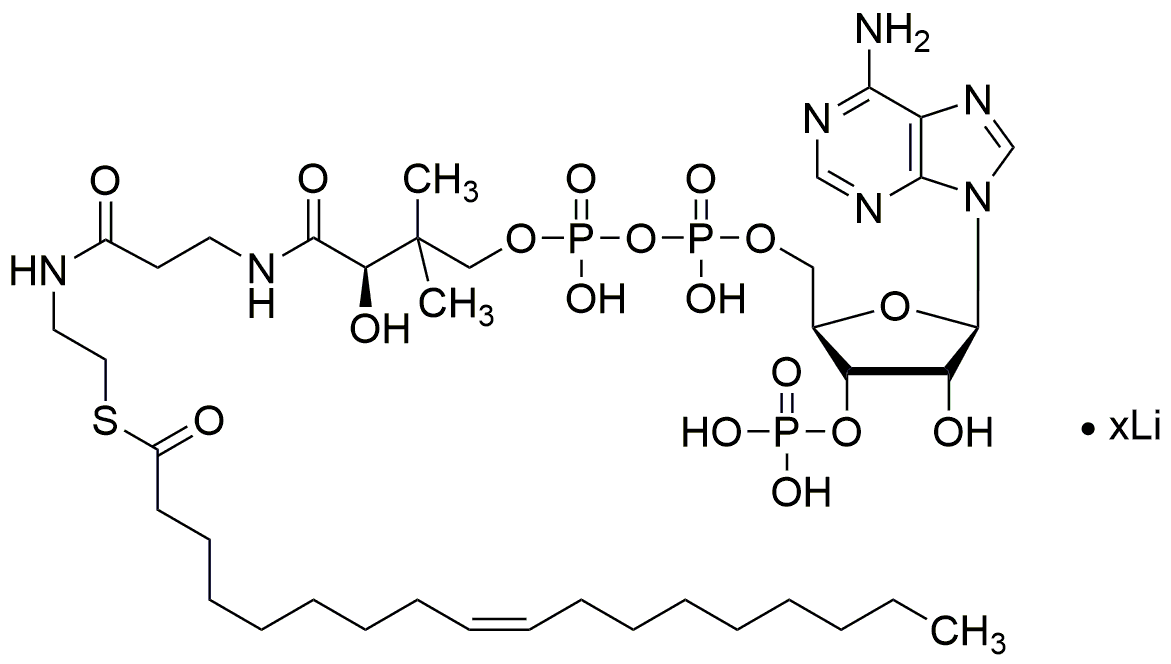Oleoyl coenzyme A lithium salt is widely utilized in research focused on:
- Biochemical Research: This compound plays a crucial role in metabolic studies, particularly in understanding lipid metabolism and energy production in cells.
- Drug Development: It is used in the formulation of pharmaceuticals aimed at treating metabolic disorders, offering a pathway to develop more effective therapies.
- Cell Culture Applications: Researchers employ this compound to enhance the growth and differentiation of specific cell types, aiding in tissue engineering and regenerative medicine.
- Enzyme Activity Studies: It serves as a substrate in assays to investigate the activity of various enzymes, providing insights into their mechanisms and potential inhibitors.
- Cosmetic Formulations: The compound is explored in the development of skincare products, leveraging its properties to improve skin hydration and barrier function.
Informations générales
Propriétés
Sécurité et réglementation
Applications
Oleoyl coenzyme A lithium salt is widely utilized in research focused on:
- Biochemical Research: This compound plays a crucial role in metabolic studies, particularly in understanding lipid metabolism and energy production in cells.
- Drug Development: It is used in the formulation of pharmaceuticals aimed at treating metabolic disorders, offering a pathway to develop more effective therapies.
- Cell Culture Applications: Researchers employ this compound to enhance the growth and differentiation of specific cell types, aiding in tissue engineering and regenerative medicine.
- Enzyme Activity Studies: It serves as a substrate in assays to investigate the activity of various enzymes, providing insights into their mechanisms and potential inhibitors.
- Cosmetic Formulations: The compound is explored in the development of skincare products, leveraging its properties to improve skin hydration and barrier function.
Documents
Fiches de données de sécurité (FDS)
La FDS fournit des informations de sécurité complètes sur la manipulation, le stockage et l’élimination du produit.
Spécifications du produit (PS)
Le PS fournit une description complète des propriétés du produit, notamment sa composition chimique, son état physique, sa pureté et les exigences de stockage. Il détaille également les plages de qualité acceptables et les applications prévues du produit.
Certificats d'analyse (COA)
Recherchez des certificats d'analyse (COA) en saisissant le numéro de lot du produit. Les numéros de lot et de lot se trouvent sur l'étiquette d'un produit, après les mots « Lot » ou « Lot de fabrication ».
Numéro de catalogue
Numéro de lot/série
Certificats d'origine (COO)
Ce certificat d'exploitation confirme le pays dans lequel le produit a été fabriqué, et détaille également les matériaux et composants utilisés et s'il est issu de sources naturelles, synthétiques ou autres sources spécifiques. Ce certificat peut être requis pour les douanes, le commerce et la conformité réglementaire.
Numéro de catalogue
Numéro de lot/série
Fiches de données de sécurité (FDS)
La FDS fournit des informations de sécurité complètes sur la manipulation, le stockage et l’élimination du produit.
DownloadSpécifications du produit (PS)
Le PS fournit une description complète des propriétés du produit, notamment sa composition chimique, son état physique, sa pureté et les exigences de stockage. Il détaille également les plages de qualité acceptables et les applications prévues du produit.
DownloadCertificats d'analyse (COA)
Recherchez des certificats d'analyse (COA) en saisissant le numéro de lot du produit. Les numéros de lot et de lot se trouvent sur l'étiquette d'un produit, après les mots « Lot » ou « Lot de fabrication ».
Numéro de catalogue
Numéro de lot/série
Certificats d'origine (COO)
Ce certificat d'exploitation confirme le pays dans lequel le produit a été fabriqué, et détaille également les matériaux et composants utilisés et s'il est issu de sources naturelles, synthétiques ou autres sources spécifiques. Ce certificat peut être requis pour les douanes, le commerce et la conformité réglementaire.


